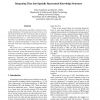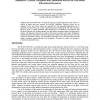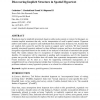EKNOW
2009
13 years 11 months ago
2009
For decades hypertext has provided a means for structuring information. Versioning has been perceived as very important for hypertext, but research focusing on it has targeted alm...
NRHM
2008
14 years 1 months ago
2008
: The World Wide Web is currently the single most popular hypertext system; however, a number of features that were common for advanced "standalone" hypertext systems are...
ECIR
1998
Springer
14 years 3 months ago
1998
Springer
The automatic construction of hypertext is an important part of the hypertext authoring process. This paper presents the NHS system, a system that automatically creates links for ...
IFIP12
2004
14 years 3 months ago
2004
: Hypertext categorization is the automatic classification of web documents into predefined classes. It poses new challenges for automatic categorization because of the rich inform...
CSREAEEE
2006
14 years 3 months ago
2006
Task information support on the Web is not always an easy and straightforward process. Much of the information is inaccurate, biased, out-of-date, or just not thorough enough. The...
HT
1987
ACM
14 years 5 months ago
1987
ACM
Hypertext is a technology well-suited to exploring different kinds of representational problems. It can be used first as an informal mechanism to describe the attributes of object...
CSCW
1992
ACM
14 years 5 months ago
1992
ACM
Today, most cooperative systems support primarily either asynchronous or synchronous (real time) cooperative work. We feel that both synchronous and asynchronous cooperation are e...
HT
1993
ACM
14 years 5 months ago
1993
ACM
Hypertexts may be implicitly structured, based on either node content or context. In this paper, we examine implicit structures that rely on the interpretation of node’s spatial...
HT
1993
ACM
14 years 5 months ago
1993
ACM
Taking the concept of a link from hypertext and adding to it the rich collection of information formats found in multimedia systems provides an extension to hypertext that is ofte...
HT
1997
ACM
14 years 6 months ago
1997
ACM
This paper describes a generic approach to structuring and visualising a hypertext-based information space on the WWW. This approach, called Generalised Similarity Analysis (GSA),...



